In which I learn to draw
May. 7th, 2020 07:49 amEarly this year, I saw a post about how it's never too late to become good at something, and another post that said something like, "Have the courage to be bad at something." I found those inspiring and decided that I wanted to learn how to draw. It's a skill I think would be cool to have, and I thought if nothing else it would be fun to be able to draw some little pictures on the postcards I send to my friend's toddler who isn't quite reading yet. This is probably a surprise to you because I decided this was something I wanted to just do for myself and not have to talk about, so I haven't told anyone about it until now.
I checked out a copy of Betty Edwards' Drawing on the Right Side of the Brain, which a friend worked through and liked, from the library. I hated it. HATED it. It might have worked better for me if I hadn't read the introduction. The introduction is essentially Edwards' manifesto arguing that drawing is a basic skill that should be taught in schools the way we teach reading and writing. While I don't necessarily disagree with her, if you start talking to me about basic skills you learn in school, then no matter how many times I tell myself that the whole point is to be bad at it, I will get stuck in mental spiral of "I am a SMART KID and SMART KIDS are GOOD AT SCHOOL and always get the RIGHT ANSWER." That was especially bad for me given that Edwards' method, at least at the beginning of the book (I didn't make it very far), is to cause your left brain to fail out so your right brain will take over. At the point that I was literally crying about it (on an admittedly hormonal day), I thought, "Maybe this isn't for me."
The next morning, I woke up and thought, "Who was that guy we used to watch on PBS?" I googled that guy, and found that he was Mark Kistler, aka Commander Mark from The Secret City and Draw Squad. I bought a copy of his book You Can Draw in 30 Days. The book is aimed at adults, but since Kistler's primary focus has been teaching kids how to draw, it has the same kind of fun, easy, encouraging tone and approach that he uses with kids. In his framing of basic drawing skills in the introduction of his book, he says that when you started learning to write, you would trace and copy letters, so when he teaches people to draw, he starts by having you copy his drawings line by line and trace pictures.
The book is arranged into thirty lessons you can do in about twenty minutes each. I spent more than thirty days on it because sometimes I went back and redid lessons if I felt like I didn't totally get it, or I split the main lesson (the basic thing) and the bonus lesson (a more advanced or creative variation) across two days. Kistler's method is to set you up for success, and he tells jokes, so working through his book was really fun. Drawing has also been a good creative activity for pandemic times. I haven't felt like writing at all - this post is the longest thing I've written in something like two months - but drawing feels easy. I don't have to come up with anything out of my own brain; I just have to copy down something that exists on a page or in real life.
I'm finding it interesting how much learning to draw has influenced how I look at the world. I pay much more attention to the shape and direction of shadows. When I'm watching Deep Space Nine, I've been thinking about how you would draw Cardassian facial features with curved contour lines and how Bajoran nose crinkles are at much sharper angles. I drew a version of my mattress and box spring one day because I kept looking at them and wondering how to modify a cube to have curved edges. Seeing the irises in bloom in my neighborhood on my walk and made me think that I'll have to google some iris pictures and see if I can figure out how to get the shapes right.
I'm never going to put enough work into drawing to become a great artist, but I'm enjoying spending some time every day drawing something. Kistler encourages you to make notes or write things down in your sketchbook. I've been putting comments on my pictures, and that's also fun. I have a lot of things that say, "Could be worse!" or, "Not terrible!" as well as a few that say things like, "How cool!"
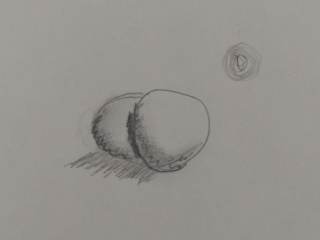
This is lesson 2: overlapping spheres (lesson 1 is the sphere; lesson 3 is advanced-level spheres). I've included it because I love what Kistler says at the end of the lesson: "Awesome job! Look at your beautiful three-dimensional rendering! A masterpiece suitable for any in-home refrigerator art gallery. You can be proud to display this great drawing on your fridge, right next to your kids' work. If you don't have kids, put this drawing up on your fridge anyway. You will enjoy seeing it with each trip to the kitchen, not to mention the oohs and ahs you will get from your friends!"
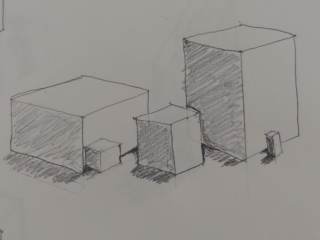
Practicing cubes. I like cubes a lot.
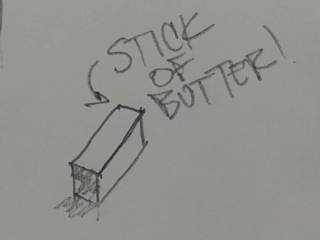
I was trying to figure out boxes of various proportions, and this one was unintentionally roughly the shape of a stick of butter.
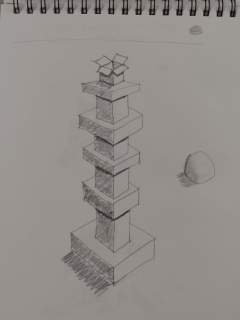
These stacking tables are really fun to draw.
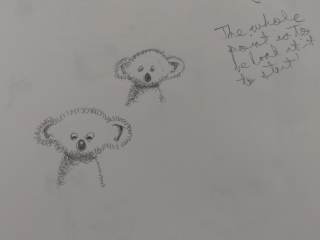
Reminding myself that it's okay if my koalas aren't great. (But they look better later than they did in the moment, which I found to be true of a lot of my drawings.)
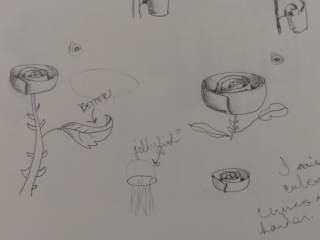
Learning to draw roses. The cut-off comment on the bottom says, "I miss cubes! Curves are harder."
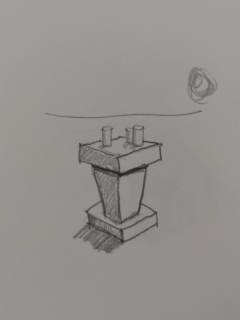
I told you tables are fun.
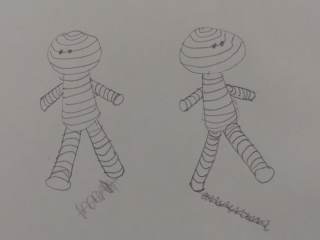
The bonus lesson from lesson 15: contour tubes. The outlines of both of these figures are the same. The only difference is the direction of the curving lines.
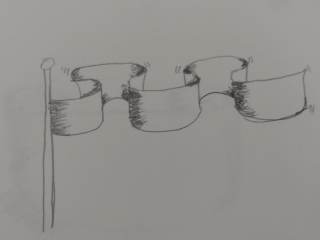
A rippling flag! I like how well this turned out.
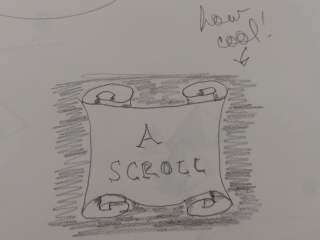
I liked how this scroll turned out.
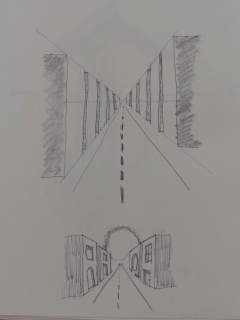
A city in one-point perspective, basic and embellished. (I was trying to put a rising or setting sun in the background, but it looks more like some sort of blob or archway.)
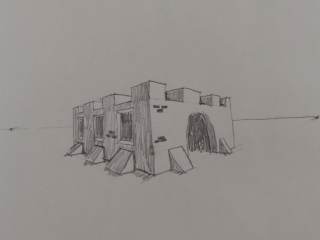
A castle in two-point perspective.
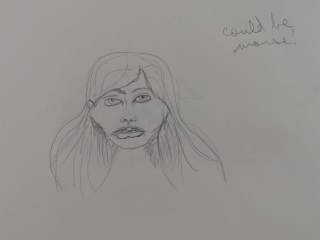
My first attempt at the human face. I've been practicing and I've gotten better since then.
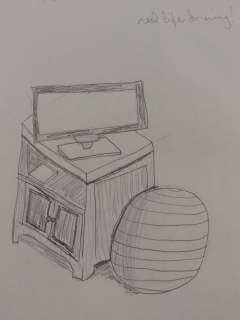
I sat on the floor and drew my TV stand.
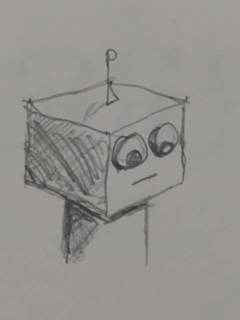
A robot. I drew this from one of Kistler's YouTube videos. I've since drawn robots on a couple of postcards.

A page from my sketchbook where I was just playing with shapes. (I'm really, really serious about liking the stacking towers.)
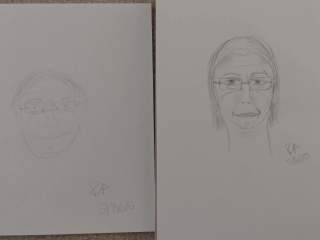
One of Edwards' pre-instruction exercises is to draw a self-portrait. One of the fascinating things about the before and after samples in the book is that everyone has a serious or neutral look on their face. I could not stop laughing when I did my before one, both because trying to draw my face without knowing what I was doing was cracking me up and because the best place for me to look at myself in a mirror for self portrait drawing is sitting on the floor of my closet. I figured I should also smile for the after one.
I checked out a copy of Betty Edwards' Drawing on the Right Side of the Brain, which a friend worked through and liked, from the library. I hated it. HATED it. It might have worked better for me if I hadn't read the introduction. The introduction is essentially Edwards' manifesto arguing that drawing is a basic skill that should be taught in schools the way we teach reading and writing. While I don't necessarily disagree with her, if you start talking to me about basic skills you learn in school, then no matter how many times I tell myself that the whole point is to be bad at it, I will get stuck in mental spiral of "I am a SMART KID and SMART KIDS are GOOD AT SCHOOL and always get the RIGHT ANSWER." That was especially bad for me given that Edwards' method, at least at the beginning of the book (I didn't make it very far), is to cause your left brain to fail out so your right brain will take over. At the point that I was literally crying about it (on an admittedly hormonal day), I thought, "Maybe this isn't for me."
The next morning, I woke up and thought, "Who was that guy we used to watch on PBS?" I googled that guy, and found that he was Mark Kistler, aka Commander Mark from The Secret City and Draw Squad. I bought a copy of his book You Can Draw in 30 Days. The book is aimed at adults, but since Kistler's primary focus has been teaching kids how to draw, it has the same kind of fun, easy, encouraging tone and approach that he uses with kids. In his framing of basic drawing skills in the introduction of his book, he says that when you started learning to write, you would trace and copy letters, so when he teaches people to draw, he starts by having you copy his drawings line by line and trace pictures.
The book is arranged into thirty lessons you can do in about twenty minutes each. I spent more than thirty days on it because sometimes I went back and redid lessons if I felt like I didn't totally get it, or I split the main lesson (the basic thing) and the bonus lesson (a more advanced or creative variation) across two days. Kistler's method is to set you up for success, and he tells jokes, so working through his book was really fun. Drawing has also been a good creative activity for pandemic times. I haven't felt like writing at all - this post is the longest thing I've written in something like two months - but drawing feels easy. I don't have to come up with anything out of my own brain; I just have to copy down something that exists on a page or in real life.
I'm finding it interesting how much learning to draw has influenced how I look at the world. I pay much more attention to the shape and direction of shadows. When I'm watching Deep Space Nine, I've been thinking about how you would draw Cardassian facial features with curved contour lines and how Bajoran nose crinkles are at much sharper angles. I drew a version of my mattress and box spring one day because I kept looking at them and wondering how to modify a cube to have curved edges. Seeing the irises in bloom in my neighborhood on my walk and made me think that I'll have to google some iris pictures and see if I can figure out how to get the shapes right.
I'm never going to put enough work into drawing to become a great artist, but I'm enjoying spending some time every day drawing something. Kistler encourages you to make notes or write things down in your sketchbook. I've been putting comments on my pictures, and that's also fun. I have a lot of things that say, "Could be worse!" or, "Not terrible!" as well as a few that say things like, "How cool!"

This is lesson 2: overlapping spheres (lesson 1 is the sphere; lesson 3 is advanced-level spheres). I've included it because I love what Kistler says at the end of the lesson: "Awesome job! Look at your beautiful three-dimensional rendering! A masterpiece suitable for any in-home refrigerator art gallery. You can be proud to display this great drawing on your fridge, right next to your kids' work. If you don't have kids, put this drawing up on your fridge anyway. You will enjoy seeing it with each trip to the kitchen, not to mention the oohs and ahs you will get from your friends!"

Practicing cubes. I like cubes a lot.

I was trying to figure out boxes of various proportions, and this one was unintentionally roughly the shape of a stick of butter.

These stacking tables are really fun to draw.

Reminding myself that it's okay if my koalas aren't great. (But they look better later than they did in the moment, which I found to be true of a lot of my drawings.)

Learning to draw roses. The cut-off comment on the bottom says, "I miss cubes! Curves are harder."

I told you tables are fun.

The bonus lesson from lesson 15: contour tubes. The outlines of both of these figures are the same. The only difference is the direction of the curving lines.

A rippling flag! I like how well this turned out.

I liked how this scroll turned out.

A city in one-point perspective, basic and embellished. (I was trying to put a rising or setting sun in the background, but it looks more like some sort of blob or archway.)

A castle in two-point perspective.

My first attempt at the human face. I've been practicing and I've gotten better since then.

I sat on the floor and drew my TV stand.

A robot. I drew this from one of Kistler's YouTube videos. I've since drawn robots on a couple of postcards.

A page from my sketchbook where I was just playing with shapes. (I'm really, really serious about liking the stacking towers.)

One of Edwards' pre-instruction exercises is to draw a self-portrait. One of the fascinating things about the before and after samples in the book is that everyone has a serious or neutral look on their face. I could not stop laughing when I did my before one, both because trying to draw my face without knowing what I was doing was cracking me up and because the best place for me to look at myself in a mirror for self portrait drawing is sitting on the floor of my closet. I figured I should also smile for the after one.